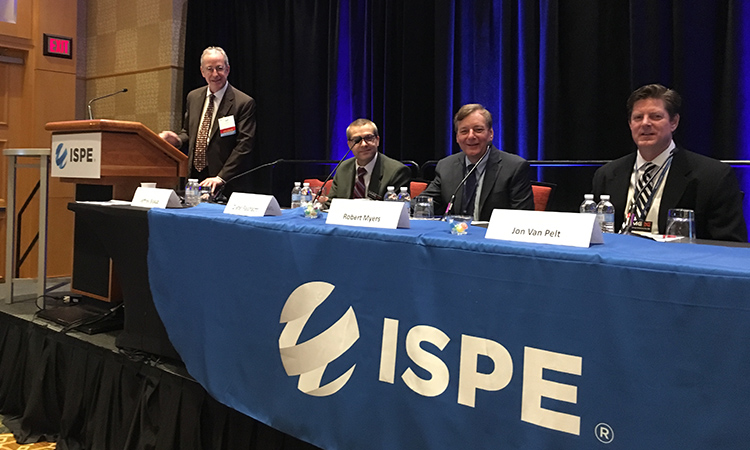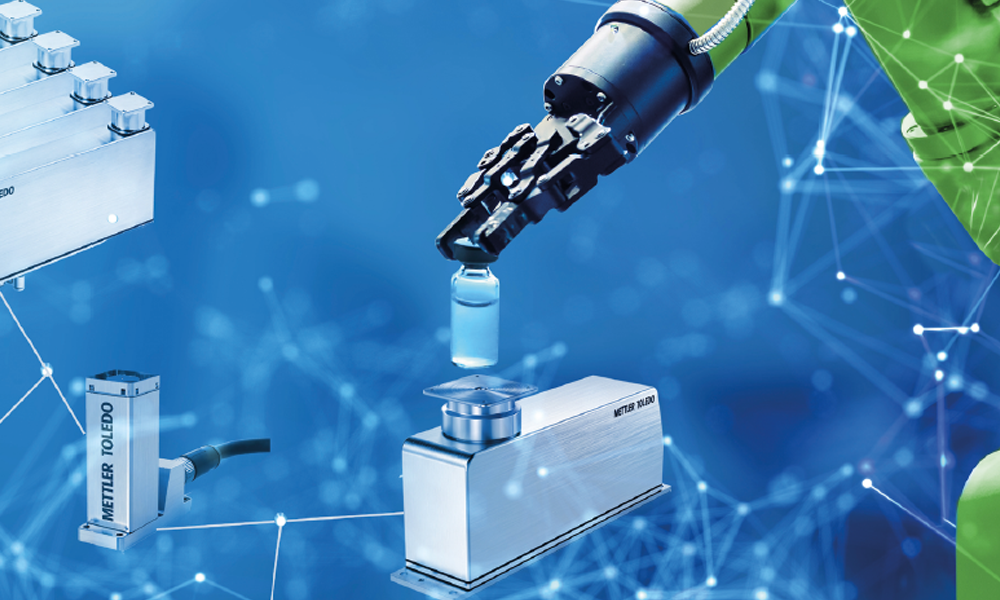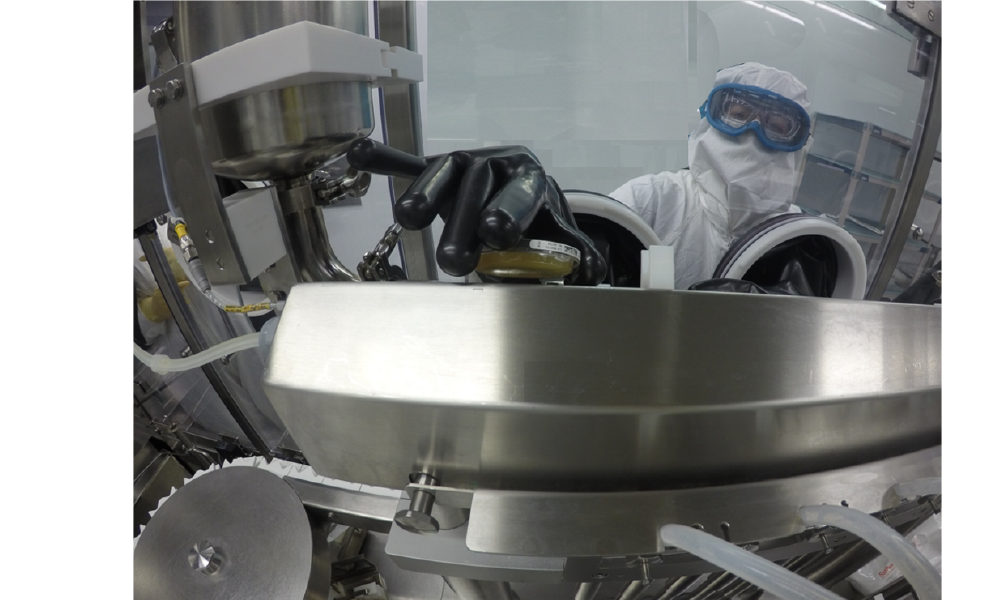2018 ISPE Facilities of the Future Conference Highlights

ISPE's 2018 Facilities of the Future Conference highlighted emerging technologies that are driving change in pharmaceutical manufacturing. Topics included virtual reality, robotics, artificial learning, machine learning, and 3D printing. Education sessions were divided into Industry 4.0 and continuous manufacturing (CM) tracks.
Keynote Presentations
Jim Breen, Project Lead, Biologics Expansion, Janssen Pharmaceuticals, and Conference Program Committee Chair, introduced the keynote presentations, explaining that facilities of the future and its corollary, workforce of the future (WOF), are strategic priorities for ISPE and the Global Manufacturing Leadership Forum (GPMLF).
Dr. Lawrence Yu, Deputy Director, Office of Pharmaceutical Quality (OPQ) at the US Food and Drug Administration’s (FDA) Center for Drug Evaluation and Research (CDER), reviewed the agency’s integration of facility evaluations and inspection programs.
CDER and the Office of Regulatory Affairs have entered into a “concept of operations” (ConOps) agreement to ensure consistency, efficiency, and transparency in facility evaluations, inspections, and regulatory decision-making for marketing applications across FDA. This will enhance quality and increase access to FDA decisions. It will also improve timelines for regulatory, advisory, and enforcement actions.
Yu said that the agency plans to meet the Generic Drug User Fee Amendments II commitment to communicate surveillance inspection classifications to facility owners within 90 days of an inspection’s completion, setting a goal of 90% for meeting this time frame in 2018.
Kent Mansfield, President, TruTag Technologies, Inc., highlighted novel uses of nanoporous silica (pSi) in pharmaceuticals. pSi can be used in nanomedicine, drug-delivery vehicles, photoluminescent devices, product authentication, and data intelligence. High-purity silicon is etched to create a uniform porosity: 10–15 nanometer (nm) pores are typical. For pharmaceutical use, the silicon is converted to silicon dioxide, then a manufacturing process similar to that used for semiconductors creates specific porosity patterns to program spectral codes. “That’s key to how we decode and read them,” said Daniels. “This process used to be highly manual. Now it’s completely robotic.” Other applications include on-dose variably coded pSi markers for solid dose products, injectable drug delivery with a pore morphology to manage elution, nanopore silica implants, which have few side effects and can be consumed by the body, unlike polymer implants. “We can use these in continuous manufacturing to identify and characterize what’s going through the process,” said Mansfield. “There’s a high potential for nanopore silica.”

Continuous Manufacturing
Several sessions provided useful overviews of individual companies’ progress in continuous manufacturing.
Eli Lilly and Company was named ISPE’s 2017 Facility of the Year Award (FOYA) Overall Winner for its continuous direct compression manufacturing plants in Indiana and Puerto Rico (see article). David Pappa, Director, Technical Services/ Manufacturing Science, Eli Lilly and Company, discussed the benefits of CM.
In batch mode, a single campaign could be weeks or months, he said. “In continuous manufacturing, we’ve streamlined and reduced that to weeks or days. And we’ve shown that direct compression in continuous manufacturing provides as much efficiency and is as good as traditional batch production.”
CM’s smaller scale also reduces development time, improves productivity, and sends product to market faster. Safety and containment are easier to manage because CM’s smaller footprint requires only about 40% of the space traditionally required. Finally, CM offers greater flexibility: on-demand batch size, multiple configurations, real-time release, and online testing save time and energy. CM also allows more efficient changeover cleanings, with single-use bags for formulation and filing.
Continuous processing presents some unique challenges, including global regulatory expectations, the need for collaboration, and appropriate guidance. “This is coming,” Pappa said, “but it’s not finished yet. There’s more road to be traveled.”
Katherine Merton, Head, JLABS, New York City and Boston, spoke about Johnson & Johnson’s collaborative approach to alternative laboratories and health care startups.
Five years ago, faced with too much lab space, J&J’s San Diego laboratory launched JLABS, a flexible, capital-efficient environment to provide lab workspace for entrepreneurs in exchange for rent. Three hundred companies are now part of this ecosystem, with 150 current residents.
Since then, JLABs has grown to eight incubator sites, with a different focus in each location: for example, pharmaceuticals in San Diego and medical devices in Houston. Entrepreneurs in JLABs can access venture capital through an investor hub. Over $9 billion has been invested to date.
Brent Liefers, Senior Director, Operations, Singota Solutions, and John Harmer, Director of Sales, Vanrx Pharmasystems, presented a case study on gloveless robotic workcells. These closed, self-contained isolators remove the need for human intervention, which is the biggest problem in aseptic filling. They also reduce surfaces for decontamination and diminish aeration times. Robotic process handling, and nested ready-to-use components eliminate container-to-container contact.
The workcell design minimizes integration problems, simplifies facility construction, and accelerates timelines to bring the facility online. Installation challenges include equipment coordination and facility timelines, as well as coordination with the FDA.

Industry 4.0
Brad Sepp, Director Manufacturing Sciences and Technology, Emergent BioSolutions, Inc., and Paul Kubera, Vice President, Process Technology, ABEC, Inc., discussed “Implementing a 4,000-Liter Single-Use Bioreactor for Large-Scale Flexible Manufacturing.”
In 2012, Emergent’s Bayview facility in Baltimore, Maryland, was designated by the US government as a Center for Innovation in Advanced Development and Manufacturing (CIADM) site to address national biologics preparedness priorities.
To meet CIADM goals, Emergent partnered with ABEC Inc., a bioprocess equipment provider, to create a highly flexible facility with the capability to run cell-culture, viral-vector, and microbial-manufacturing processes. The design features 50 to 4,000-liter (L) single-use bioreactors configured for rapid response and changeover. The expansion project earned Emergent an Honorable Mention in ISPE’s 2017 FOYA Awards.
The facility’s flexible design improves productivity and reduces costs; it also permits process transfer flexibility. During the 2015 Ebola outbreak, for example, the company manufactured a proof-of-concept vaccine candidate in less than four months. A technology transfer from GlaxoSmith-Kline for raxibacumab, a monoclonal antibody for inhalational anthrax, was previously licensed at 1,600 and 20,000 L in stainless steel. Emergent performed a 50-L transfer run in ABEC’s custom single run technology. “The question was whether the cells would grow the same way in plastic. And the 50-L test showed that they did,” said Kuba.
Rick Lu, Director, Manufacturing Technology and Innovation, AstraZeneca, and Timo Simmen, Director, Parenteral Technology Innovation & Standardisation, Janssen, both members of the BioPhorum Operations Group (BPOG), gave an update on the Biomanufacturing Technology Road Map.
The first edition of the Technology Roadmap, published July 2017,∗ identified enabling technologies and capabilities. The scope of the second edition BPOG Technology Roadmap is currently under discussion, with finalization scheduled for November 2018. Options being considered are process development, drug substance, drug product, disruptive technologies, cell and gene therapy, vaccines, and new expression systems.
Lu asked attendees to consider discussing participation with their companies. “There’s plenty of time to get engaged and think about how to contribute,” he said.
*Available on the BPOG public website: https://www. biophorum.com/executive-summary
Nicole Monachino, Vice President, Business Operations and General Counsel, Quality Executive Partners, presented an overview of Virtuosi, a virtual reality educational platform developed in response to industry concerns about worker training. The Virtuosi system simulates a complete floor-to-ceiling lab environment and provides visualizations only possible with virtual reality, like airflow and patterns studies. The programming is highly sensitive to motion and order of operations. (Virtuosi’s demonstration booth and 3D headset were a conference highlight.)
“You get to go into a virtual lab and perform tasks,” Monachino explained. “You get immediate feedback. You can actually pick up a vial. It even shows you if you skip a step. When you wash your hands, it checks to make sure you’re doing it correctly and rinsing enough.”
Compared to traditional training, Monachino said, retention from virtual reality training is as high as 80%, and it enables critical thinking. Both reduce downtime and risk.
Jason Collins, Director, Process Architecture, IPS, discussed aseptic manufacturing, citing the need for multipurpose facilities that can adapt to new technology. Other challenges include global compliance, the need for quick adaptation to new business drives, and lack of space for phasing and expansion.
Heating, ventilation, and air-conditioning systems can be installed directly above the rooms they support. Interstitial space can provide access for maintenance, drainage from product areas does not need to be underground, and critical utilities can be directly below the systems they support. Robotics and smaller, modular, multiformat, movable units can reduce space requirements. Filling lines can be contained in the room, below the ceiling.
Flexibility can also be built in by eliminating columns on the production floor so structural elements don’t interfere with equipment arrangements or maintenance access. Modular air-handling units and ductwork penetrations allow reconfiguration as needed. Open positions permit future phasing and expansion. Removable floors can allow renovation without disrupting production. Architectural solutions, combined with modular, scalable, expandable construction, can also improve facility performance.
Margaret Prendergast, Director of Bioengineer, Allevi (previously BioBots), Inc., shared her work on bioprinting, which she called “the future of medicine.” Bioprinting uses a 3D printing process to create synthetic human tissue by outputting layer upon layer of living cells, growth factors, and biomaterials to fabricate biomedical parts.
Allevi’s goal is to put “a 3D printer on every scientist’s desktop, at a fraction of the cost,” Prendergast said. The company’s first product was a $10,000 extruder. Alevi now produces bioprinters, materials, bioinks, and software.
“Our customers have had great success,” she noted, citing benchmarks such as printing bone and soft materials such as an artery and mouse kidney, automated methods to print cancer tumor models that are combined with bioprinted liver models for drug testing, and the first thrombosis on a chip that can test a variety of drugs.
Future goals include automated tissue printing for trachea, cartilage, bone, skin, heart, liver, lung, kidney, blood vessels, brain, nerve, and muscle tissues, mostly for drug testing.
Mike Adelstein, President and CEO, Potomac Photonics, presented his work on advanced micro manufacturing technologies, which can produce microdevices as small as 1 micrometer (µm). The diameter of a human hair, for comparison, is 75 µm. Laser micromachining is compatible with a wide range of materials and can drill holes with m-level precision. “We laser machined 25,000 1.9-µm holes in less than 5 minutes ... in stainless steel!” Adelstein exclaimed. Microchanneling, a process that has been extremely expensive in the past, can now be done at a fraction of the cost. Micro-3D printing can be used to study how cells interact in various configurations. “We’re trying to get down to 10 m or less in 3D printing,” he said. Initiatives include 3D printed microfluidics chips to identify early cancer cells.
Other possible applications include brain catheters, tiny channels for radiation cancer therapy, implantable lenses, 3D printed organs, and testing for antibiotic susceptibility.

Dhruv Patel, CEO, and Christopher Look, CTO, Synapto LLC, showed how a portable electroencephalogram (EEG) and artificial intelligence can diagnose Alzheimer’s disease earlier and at a fraction of the current cost, using a lightweight noninvasive headset that captures EEG data of both resting and active brain waves called evoked related potentials, which are created as the patient presses the space bar when he or she hears a high tone.
Data sets were gathered from 256 patients in Brazil, Greece, and the United States. Results were analyzed by machine learning and deep learning mathematical models. Cross-validation distinguished true positives from false positives. In the Greek data set, the system diagnosed Alzheimer’s correctly with 82% accuracy—better than other researchers around the world.
A pilot clinical study is planned for 60–80 at-risk early-stage patients. In the future, Patel and Look hope to develop presymptomatic testing as well as analyze disease progression.
Kathryn Colonna Worrilow, PhD, Founder and CEO, LifeAire Systems, shared the story of LifeAire Systems. Through live monitoring of contaminants such as volatile organic compounds (VOCs), chemical pathogens, HVAC components, and other toxic substances in an in vitro fertilization lab, Worrilow and her team learned that airborne contaminants at parts-per-billion levels were affecting clinical outcomes. Worrilow developed a system to provide sterile air, with chemical and biological pathogens below detection levels on a single pass at reduced air-changes per hour.
The system has 22 patents to date, with others pending. LifeAire has been installed in more than 35 clinical facilities in the United States, including the Mayo Clinic; others are in China and Canada.
Dr. Juandria Williams, Branch Chief (Acting), CDER/OPQ/OPF/DIA, offered the FDA’s perspective on emerging technology. The FDA developed its Emerging Technology Team (ETT) in 2015 to encourage the adoption of innovative technology. With ETT’s help, FDA has identified CM as an emerging technology with the potential to increase the efficiency, flexibility, agility, and robustness of pharmaceutical manufacturing. Since 2015, it has approved four new drugs produced by CM—one of which had previously been approved for patch process—and played a critical role in approving the first 3D-printed drug product.
Robert Blouin, PharmD, Provost, University of North Carolina (UNC) at Chapel Hill, told how he developed a culture of collaboration and innovation at the Eshelman School of Pharmacy. Blouin came to UNC in 2003 and encouraged the university to see its opportunity to play a major role in drug discovery. By securing support from the board and forming strategic partnerships, Blouin transformed the school: The student population doubled, faculty tripled, and research space quadrupled. National Institutes of Health funding increased by 1,800%. Additional transformations followed with a series of donations totaling $133 million from Dr. Fred Eshelman, CEO and founder of PPD Inc., for whom the school is named. UNC at Chapel Hill soon became one of the top-ranked pharmacy schools in the world. The path to success, he continued, starts with a vision and a strategic plan. Hold people accountable for their work and realize that you may have to do unpopular things to create change. Hire the right people, or they won’t be productive. Look for inquisitiveness, resilience, and adaptability. Invest in people for the long term. “If you don’t have the right people, you can’t compete. You just can’t.” Finally, “we have to transform our culture of thinking, Blouin said, “and get people to think differently. That’s our biggest challenge—and our greatest opportunity.”
Workforce of the Future
Robots and Super-Profiles
Dr. Antonio Moreira, Vice Provost for Academic A airs, University of Maryland, Baltimore County (UMBC), spoke about preparing the biopharmaceutical WOF— a workforce that he warned is already in short supply. In the next 5 to 10 years the global pharmaceutical industry will need a highly skilled workforce with competencies that include CM technologies, 3D printing, combination products, automation, big data management, CAR T-cells, and other new specialties.
To meet the demand, the GPMLF Workforce of the Future Initiative is developing curricula that will prepare students for industry. GPMLF is in partnership with several universities, since industry and academia must work together to build the WOF. Sponsored by the GPMLF and ISPE, UMBC’s WOF team also works with students in middle and high schools. Dr. Moreira and his team have identified 13 “super-profiles” necessary for the pharmaceutical WOF, including bioassay scientist, automation engineer, microbiologist, and device technology expert. Each requires cross-functional skills, such as data management and analytics, in addition to technical expertise.
Jay Douglass, Chief Operating Officer, Advanced Robotics for Manufacturing Institute (ARM), noted that robots will be a large component of the WOF and discussed an initiative that is helping to drive its development.
ARM is a nonprofit consortium that facilitates robotic solutions in manufacturing. Founded by Carnegie Mellon University in 2017, it has 150 members in manufacturing, academia, technology, government, and regional economic development. Completed projects may be licensed to other ARM participants.
Douglass urged attendees to share ideas about how robotics could work in the pharmaceutical industry. “Facilitate your investment in your own future,” he said.



